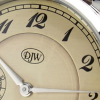My First Test Dial Printing...i'm Over The Moon!
-
Recently Browsing
- No registered users viewing this page.
-
Topics
-
Posts
-
The stress is the force (on the spring) x distance. The maximum stress is at the bottom, and decreases up the arm. That's why they always break at the bottom. I used a round file, then something like 2000 grit to finish. I gave the rest of the arm a quick polish - no need for a perfect finish. Just make sure there are no 'notches' left from cutting/filing. The notches act like the perforations in your toilet paper 🤣
-
It's probably a cardinal rule for watch repair to never get distracted while at the bench. Yesterday, after finishing a tricky mainspring winding/barrel insertion (I didn't have a winder and arbor that fit very well) I mentally shifted down a gear once that hurdle was passed. There were other things going on in the room as I put the barrel and cover into the barrel closer and pressed to get that satisfying snap. But when I took it out I realized I never placed the arbor. When opening a barrel, we are relying on the arbor to transfer a concentrically-distributed force right where it is needed at the internal center of the lid. However, when that isn't present it's difficult to apply pressure or get leverage considering the recessed position of the lid, the small holes in the barrel and the presence of the mainspring coils. It was a beat-up practice movement so I didn't take a lot of time to think it over and I pushed it out using a short right-angle dental probe placed in from the bottom, but that did leave a bit of a scratch and crease in the thin lid. I had also thought about pulling it using a course-threaded screw with a minor thread diameter smaller than the lid hole and a major diameter larger, but that may have done some damage as well. Thinking about how this might have been handled had it been a more valuable movement, is there a method using watchmaking or other tools that should extract the lid with the least damage?
-
By Neverenoughwatches · Posted
🤔 what happens if lubrication is placed directly on top of epilame ? Making a small groove so the lubrication doesn't spread across the component but what if when lubing a little overspills and sits on the epilame . -
By Neverenoughwatches · Posted
Why just the bottom mike ? Is it worth polishing the whole arm ? -
The one thing I took time over was to round and polish the curves at the bottom of the jumper arm. The slightest mark (left over from cutting of filing) acts as a stress raiser, just where you don't need it.
-







Recommended Posts